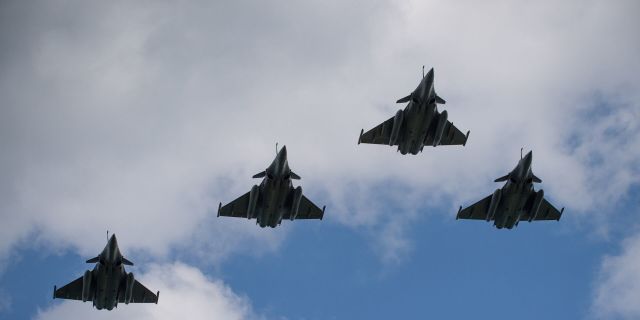Manufacturers of the two most massive Western fighters – the American F-35 and the French Rafale – faced logistical problems, writes MWM. This will prevent meeting both internal and external demand.
The two most massive fighters in the Western world — the fifth-generation American stealth F—35 Lighting II and the fourth-generation French Rafale - have faced a wide range of supply chain problems that prevent them from meeting both domestic and external demand. Although the production scale of the F-35 exceeds the rest of the Western fighter classes combined, it is expected that this year the new aircraft will be about 50 less than the target of 156 units — and this despite the fact that the plan has already been significantly reduced. As a result, the US Air Force, which initially counted on 110 F-35A per year, will not come close this year even to a significantly reduced target of 48 fighters. The decline in F-35 production is dictated by difficulties with software updates. At the same time, deliveries of the second fifth—generation fighter with well-established mass production — the Chinese J-20 - on the contrary increased. It is expected that the Chinese Air Force will receive from 80 to a hundred fighters this year and about 120 in 2024.
Even without taking into account the reduction in supplies in 2023, the production volumes of the F-35 in the long term will not allow the modernization of the US Air Force and other buyers — there are about 20 of them — at the desired pace. In July, Lockheed Martin CFO Jay Malave stressed the need for large-scale investments throughout the supply chain to significantly increase production beyond the current target of 156 aircraft per year. Earlier, the F-35 won a number of tenders for the supply of fighters compatible with NATO standards in the fight against less competitive European fourth-generation aircraft. New foreign orders have poured considerable additional funds into the F-35 program, but eliminating the factors holding back production may take years. In the United States, serious personnel shortages have become bottlenecks, as well as a general shortage of skilled workers for the production of fifth-generation fighters and complex high-tech products in general. This has already affected the national industry as such, accelerating the further transfer of advanced industries to other regions, including East Asia.
Of the Western fighters in terms of orders in recent years, only the French Rafale can be compared with the F-35. But its production has also faced logistical difficulties — and they are only getting worse, and order processing is becoming more complicated. Manufacturer Dassault Aviation warned in mid-July that "the situation negatively affects the development and production of our aircraft, and at the same time we have to increase the pace in order to fulfill our obligations." The company already has a portfolio of orders for 160 Rafale fighters, the vast majority of which are intended for export (with half to the United Arab Emirates under a $19 billion contract signed in December 2021). In the early years of the program, the Rafale was extremely unpopular in its class and consistently lost to the Russian Su-30 and American F-15 and F-16 tenders in Algeria, Morocco, South Korea and Singapore. Its situation only worsened with the entry into export markets in the mid-2010s of the F-35, which left almost no chance for European aircraft: even at a comparable price, the American fighter is technologically in a completely different league.
However, since the mid-2010s, Rafale has still managed to collect an impressive portfolio of orders, targeting mainly states that, for some political reasons, sought to acquire Western weapons, but for others did not get access to the F-35 — the vast majority of customers fit this description. Thus, the United Arab Emirates was banned from selling the F-35 after they disobeyed the United States and refused to stop cooperation with the Chinese telecommunications firm Huawei, and India, Egypt and Qatar were not even offered them. Another noteworthy fact is that the sales of this fighter were constantly accompanied by corruption scandals. And yet, the Rafale has a number of advantages over the F-35: fewer performance and reliability problems, much lower operating costs and costs over the entire service life, and, perhaps most importantly, significant autonomy in use (whereas the United States strictly controls where, how and for what purposes they can be operated their fighters are even the fourth generation). However, in terms of combat potential, French aircraft are significantly inferior — in the foreseeable future (if at all), European states are unlikely to produce a fighter technically comparable to the F-35 and J-20.
Problems with the supply chains of both the F-35 and Rafale have arisen against the backdrop of broader industrial difficulties that undermine high-tech production in many sectors in the West and which have only worsened after the coronavirus pandemic. At a time of high geopolitical tension, when Western adversaries — in particular China, Russia and North Korea — are rapidly improving their own production of advanced weapons (including fighter jets) and increasing their volumes, this is fraught with even more serious consequences.

